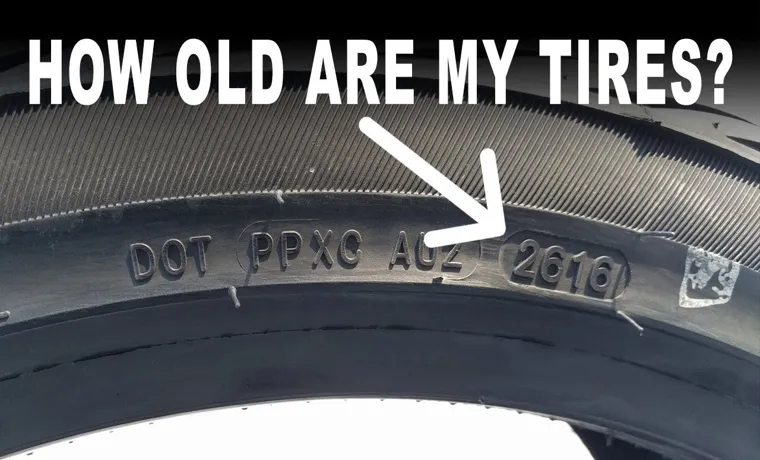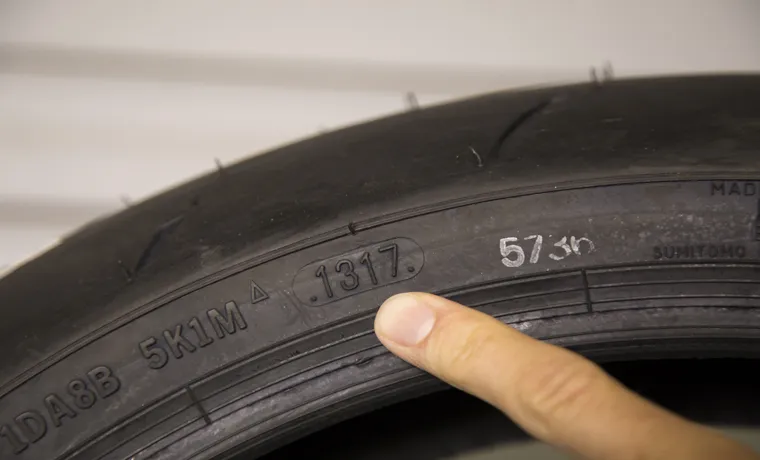When was the last time you checked the age of your motorcycle tires? It’s no secret that the condition of your motorcycle tires can mean the difference between a safe ride on the open road and a potentially hazardous one. That’s why it’s important to determine the age of your tires and understand when it’s time to replace them. In this blog post, we’ll delve into the details of determining the age of your motorcycle tire, and why it’s crucial to keep your tires up to date.
From understanding the manufacturing date to identifying signs of wear and tear, we’ve got you covered. So sit back, grab your helmet, and let’s dive in!
Table of Contents
Check the Sidewall of the Tire
If you’re wondering how to tell the age of a motorcycle tire, the first place to look is the sidewall of the tire. Most tires have a stamped code that indicates when it was manufactured. The code usually begins with the letters “DOT,” followed by a series of numbers and letters.
The last four digits of the code indicate the week and year the tire was made. For example, “4518” would mean the tire was made in the 45th week of 201 It’s important to check the tire’s age because even if the tire has plenty of tread left, an old tire can become brittle and more susceptible to blowouts.
Some experts recommend replacing tires that are more than 5 years old, regardless of how much tread is left. So, take the time to check your tires’ age to ensure your safety on the road.
Look for the DOT Code
When it comes to checking the safety of your tires, one crucial step is to look for the DOT code. This can easily be found on the sidewall of the tire, and it contains important information. The DOT code is a series of letters and numbers that indicate the manufacturer, size, and other vital details about the tire.
It is essential to ensure that the DOT code matches the type of tire recommended for your vehicle. By checking the DOT code, you can also determine the age of the tire and whether it needs to be replaced. Remember that the safety of your vehicle depends on the condition of your tires, so make sure to check the DOT code.

Read the Numbers
When it comes to checking the condition of your tires, it’s crucial to know how to read the numbers on the sidewall. The information printed on the tire provides important details about its size, type, and performance capabilities. To get started, look for a series of digits, typically located on the outer edge of the tire.
The numbers will be arranged in a sequence, such as P235/60R1 The first letter or series of letters indicates the tire’s type, such as P for passenger or LT for light truck. The three-digit number following the letter represents the tire’s width in millimeters from sidewall to sidewall.
The two-digit number after the slash refers to the tire’s aspect ratio, which is the height of the sidewall relative to the width. The letter following the aspect ratio denotes the tire’s construction, with R representing radial construction. Finally, the two digits that follow indicate the diameter of the wheel in inches that the tire is designed to fit.
By understanding the information printed on your tire, you can make informed decisions about your vehicle’s safety and performance.
Decoding the DOT Code
When it comes to ensuring your safety on the road, checking your tire’s sidewall is crucial. The Department of Transportation (DOT) requires all tires sold in the United States to have a code on their sidewall, which can help you identify the tire’s manufacturing date, size, and other important information. This code usually starts with the letters “DOT,” followed by a series of numbers and letters.
For instance, “DOT 7BCD 1234” would indicate that the tire was manufactured during the seventh week of 2014 and that it meets DOT regulations. Knowing how to read this code can help you make informed decisions about your tire’s performance and lifespan. So, next time you’re inspecting your tires, be sure to check the DOT code on the sidewall to stay safe on the road.
Understanding the Four-Digit Date Code
When it comes to understanding the age of your tires, checking the four-digit date code on the sidewall can provide important information. This code tells you when the tire was manufactured, with the first two digits indicating the week and the last two indicating the year. For example, if the code reads 4317, the tire was made in the 43rd week of 201
It’s essential to check the date code because even if your tires look fine, they can still degrade over time due to factors like heat and exposure to the elements. Tires older than six years should be inspected by a tire professional, as they may no longer be safe to use on the road. So, if you’re in doubt about the age of your tires, take a look at the sidewall and ensure your safety on the road.
Inspect the Tread Wear
If you want to know the age of a motorcycle tire, one of the best things to check is the tread wear. While this won’t give you an exact age, it will give you an idea of how much the tire has been used. Tires that have been used frequently will show significant wear, with the tread looking thinner and shallower.
On the other hand, if the tire has hardly been used, the tread will look deeper and more defined. Additionally, if you notice uneven wear, this could be a sign of other issues with the tire or the motorcycle itself. If you’re in doubt about the age or condition of a tire, it’s always best to err on the side of caution and replace it if necessary.
Remember, the safety of yourself and others on the road is paramount, so don’t take any chances when it comes to your motorcycle tires.
Consider the Wear and Tear
When it comes to maintaining your vehicle, checking the wear and tear on your tires is essential. One of the simplest ways to do this is to inspect the tread on your tires. This will give you a good idea of their condition and whether they need to be replaced.
A general rule of thumb is that if the tread is less than 2/32 of an inch deep, it’s time for new tires. Tires with worn tread not only compromise your vehicle’s handling and performance but are also a safety hazard. If you drive on wet or slippery roads, the lack of tread can increase the risk of hydroplaning or losing control of your vehicle.
So, always check your tire tread regularly and replace worn tires promptly to ensure your safety and that of your passengers on the road.
Determine Mileage and Usage
When inspecting your tires, it’s important to take note of the tread wear. Tread is the rubber on the outer circumference of your tire that provides traction and stability. If the tread is severely worn down, it could be dangerous to drive on and you may need to consider getting new tires.
To check your tread, you can use the penny test. Place a penny upside down in the grooves of your tire. If you can see the top of Lincoln’s head, then your tread is too worn and it’s time to replace your tires.
Additionally, the type of wear on your tread can indicate underlying issues with your car’s alignment or suspension. Feathering or cupping are common patterns of uneven wear that may signal a need for repairs. By keeping an eye on your tire’s tread wear, you can ensure that you’re driving safely and avoid any potential hazards on the road.
When to Replace Your Motorcycle Tire
If you’re a motorcycle rider, one of the most crucial things you should always keep an eye on is the condition of your tires. Tires are the only contact point between your bike and the road, and a worn-out tire can be dangerous and lead to accidents. So, how can you tell the age of your motorcycle tire? Most tires come with a manufacture date stamped on them, represented by a string of numbers.
The last four digits indicate the week and year of manufacture, respectively. For example, if the number is “2418,” it means the tire was produced in the 24th week of 201 However, keep in mind that even if a tire looks new, it could be old and dry-rotted and should be replaced nonetheless.
It’s recommended to replace your motorcycle tires every five years because the rubber compounds can break down and lead to loss of traction, decreased handling, or even blowouts. Therefore, remember to check your tire’s age regularly and replace them promptly if they’re old or show signs of damage.
Factors That Impact Tire Longevity
Motorcycle tire As a motorcycle rider, you need to understand the factors that affect your tire longevity. The lifespan of your motorcycle tire depends on several factors such as weather conditions, road conditions, and your riding style. If you are a fan of high-speed riding and aggressive cornering, your tire will wear out faster than someone who prefers a slow and cautious riding style.
The weather is also a critical factor as extreme heat or cold can shorten the lifespan of your tire. Likewise, the road conditions, such as rough terrain or sharp turns, can impact the durability of your tire. To ensure you get the best performance from your tires, it’s important to inspect them regularly.
Look for signs of wear or damage such as cracks or bulges, and replace them as soon as you notice any issues. Remember, your motorcycle tire is your only connection to the road, and ensuring they are in good condition is critical to your safety.
The 5-Year Rule
As a motorcycle owner, it’s crucial to know when to replace your tires. It’s not just about wear and tear, but also the age of the tires. The 5-year rule is a good guideline to follow when it comes to replacing your motorcycle tires.
Even if the tread looks okay, the rubber can still deteriorate over time, making it unsafe to ride. This is especially important if you live in an area with extreme temperatures or harsh weather conditions. Be sure to check the manufacturing date on your tire, which is stamped on the sidewall.
If it’s close to the 5-year mark or already past it, it’s time to replace your tire. Don’t take any chances when it comes to your safety on the road. Keep yourself and others safe by replacing your tires as needed.
The 10-Year Rule
As a motorcycle owner, it is important to understand the 10-year rule when it comes to replacing your motorcycle tire. This rule states that regardless of the tire’s condition, it should be replaced after it has been in use for ten years. The reason for this is that over time, even if the tire has not been used much, the rubber tends to dry out and become brittle, making it more susceptible to damage or failure while riding.
It is also important to note that if you notice cracking or other signs of wear on the tire, it is best to replace it even if it has not reached the ten-year mark. The safety of the rider and the passengers should always be the top priority, and regularly checking and replacing your motorcycle tire is an essential part of keeping everyone safe while on the road.
Conclusion and Final Thoughts
In conclusion, determining the age of a motorcycle tire is crucial for maintaining your bike’s safety and performance. Remember to check the DOT code on the sidewall of the tire and look for the last four digits, which reveal the week and year of manufacture. If your tire is over six years old, it’s time to consider replacing it.
And just like a fine wine or a good cheese, age can add character, but it’s better not to take any chances when it comes to your motorcycle. So, keep your ride safe and fresh by staying on top of your tire’s age. Happy riding!”
FAQs
What is the manufacturing date on a motorcycle tire?
The manufacturing date of a motorcycle tire is usually represented by a four-digit code on the sidewall. The first two digits indicate the week of the year and the last two digits indicate the year of manufacture.
When should I replace my motorcycle tires based on their age?
Generally, a motorcycle tire is considered to have reached the end of its useful life after about 5 years from the date of manufacture, regardless of the tread depth or wear.
How can I tell if my motorcycle tires are too old?
Cracks and dryness in the tire’s sidewall, or the rubber feeling brittle to the touch, are signs that the tire is too old and needs to be replaced, even if there is still plenty of tread depth.
Is it safe to ride on old motorcycle tires with good tread depth?
No, it is not safe to ride on old motorcycle tires with good tread depth. The rubber compound in the tire deteriorates over time, making it more prone to failure, which can result in a serious accident.
How can I prolong the life of my motorcycle tires?
You can prolong the life of your motorcycle tires by keeping them properly inflated, avoiding overloading your bike, and keeping your tires out of direct sunlight and away from heat sources.
Can I mix tire brands on my motorcycle?
It is not recommended to mix tire brands on your motorcycle because different tires may have different handling characteristics, which can affect the performance and safety of your bike.
How do I know what size motorcycle tires to buy?
You can find the size information for your motorcycle tires on the sidewall of your current tires or in the owner’s manual for your bike. It’s important to buy tires that are the correct size and type for your motorcycle.



